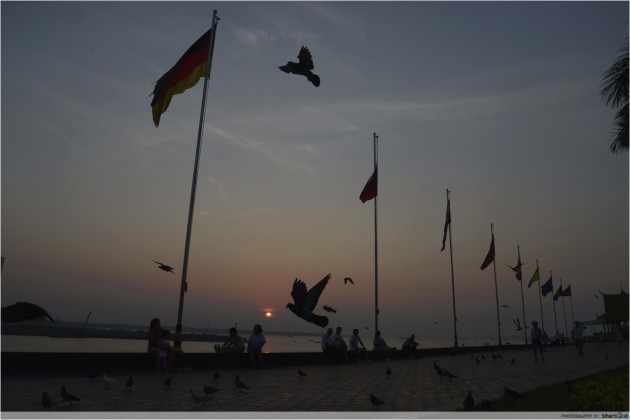A Stroll Along Phnom Penh’s Sisowath Quay
Khmer rap booms from a small, battered speaker as enthusiastic middle-aged women windmill their arms, in sync with the beat. My tuk-tuk driver pulls to a halt beside the exercise troupe and looks quizzically at me.
“Here?” he asks, a frown creasing his face. When I affirm, he shrugs and says, “One hour is enough. There is nothing to do for tourists.”
I hand over a wad of crumpled riel before he hits me with a parting shot. “You want to stay from sunrise to sunset? You can’t even see the sunset here.” With that, he guns the engine and disappears.
I have arrived at Sisowath Quay.
A sprawling 3-kilometre-long promenade parallel to the Mekong River, Sisowath Quay is Phnom Penh’s main boulevard — famed for its bustling activity and stunning views.
Expectations and camera primed accordingly, I clamber up the riverfront parapet. But, other than turgid grey water and a partially obscured sunrise, little is worth a second glance. I make out the shapes of trawlers on the horizon, but they chug off in the opposite direction.
Behind me, the throbbing beat soon fades, with participants drained from the routine. Apart from the lone elderly man shuffling past, there is little other sign of life. Perhaps my driver was right.
A loud squeal breaks my melancholia.
A toddler in an “Angry Birds” T-shirt rushes along, clutching a packet of birdseed. She scoops a fistful of granules, tossing them on the ground. Almost instantly, a flock of pigeons descend in a flurry of flapping wings.
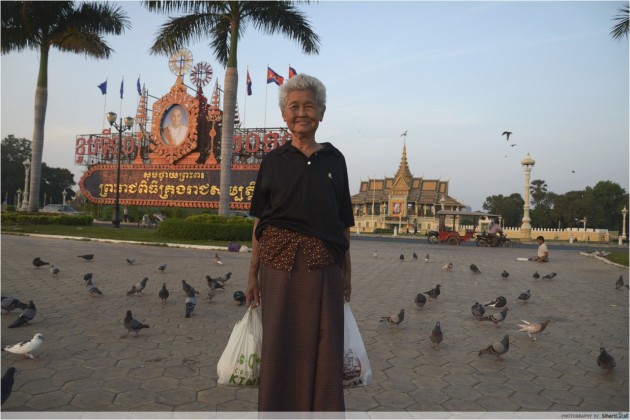 A pigeon-feed seller poses with her wares
A pigeon-feed seller poses with her wares
Her parents chuckle and slip some money to a wizened woman heaving a sack of feed.
Intrigued by the feeding frenzy, I buy a packet of my own and scatter the seeds at the throng. Still hungry, they gobble up the second helpings to a chorus of squawks.
The experience gives me pleasure, as I dole out breakfast like venerable Mother Teresa.
However, as more feathered ruffians converge, I am overwhelmed. Some swoop inches from my face, others attempt to dive bomb my hands and a particularly adventurous bird tries to use my head as a landing pad.
I decide enough is enough, dumping out the rest of the packet before beating a hasty retreat.
Local Entertainment
As the sun makes a belated appearance, the joggers come out of hiding. Clad in singlet and shorts, they breeze past, shoes thudding on the pavement.
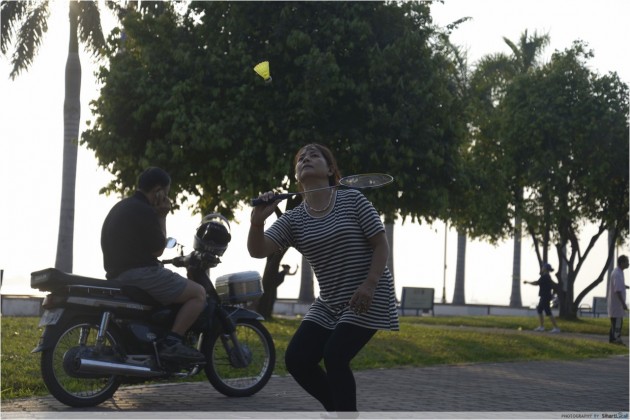 Badminton is a popular recreational sport for exercising locals
Badminton is a popular recreational sport for exercising locals
Following their trail, I spot two women preoccupied with a game of badminton along a makeshift court — its boundaries demarcated with faint chalk scrawl. Their eyes remain glued to the neon-yellow shuttlecock they thwack back and forth.
Drawn by the spectacle, I stop, stare and soon realise I am now almost late to meet my guide.
Fortunately, I see him sitting by the steps of a roadside restaurant. Buntheng, or Theng as he tells me to call him, greets me with a smile and a firm hand-shake. “So, we will be here for the rest of the day?” he asks. “No problem, this is an interesting place.”
Over warm Cokes, Theng tells me how the Mekong begins as a trickle in Tibet and is fed by various tributaries. It branches into countless arteries, before flowing into Cambodia. At the centre of the Quay, the upper and lower Mekong merge and meet the smaller Tonle Sap and Tonle Bassac rivers.
This confluence of the four rivers is where Buddhists gather at a shrine to pray and offer gifts daily. Theng promises to show me this special spot later as we extricate ourselves from the shade.
 Tuk-tuk drivers engrossed in a game of Khmer Chess (Ouk)
Tuk-tuk drivers engrossed in a game of Khmer Chess (Ouk)
We press on, the boardwalk narrowing into a pavement which gently curves along the bustling road. Soon, our view of the Mekong is obstructed. Under a beige sign which reads “Himawari Hotel and Apartments”, a group of tuk-tuk drivers crouch over a thick wooden chessboard. The centre of attention are two men sitting cross-legged, deliberating over the carved pieces.
This is Ouk or Khmer chess, a variant of its English counterpart. While the objective of the game remains capturing the opponent’s king, there are new pieces such as touk (boat), koul (pillar) and trey (fish).
The cacophony of groans and guffaws grow as vanquished pieces are tossed into an empty milk tin.
Tourist Observations
A tourist slips through the hotel gates and in a flash, half the audience converges on him. As he is ushered away by a victorious driver, the chess game also concludes, leaving the defeated to slink back to his vehicle.
The hotel marks the southernmost end of Sisowath Quay. After a quick stop for lunch, we retrace our footsteps and head back.
A handful of battered yellow umbrellas block our path. A bevy of women in long-sleeved floral tops slump on wooden loungers, their tired faces masked by broad-brimmed straw hats. They are surrounded by mounds of coconuts — each meticulously adorned with a folded lotus bud. Piles of unripe bananas sit stacked on the white fold-out tables.
Theng explains that these stalls cater to locals who purchase fruits to be offered at the shrine. “Cambodians also give lotus flowers because they represent purity and cleansing,” he adds.
Suddenly, he grips my hand and gestures at a bespectacled, pot-bellied man arranging incense sticks meticulously at a make-shift altar. “You should get your fortune told, it will be good for you,” Theng says.
Noticing my scepticism, he tells me how a fortune-teller cured his nephew who was possessed by an evil spirit.
While I have no such concerns, I agree that it wouldn’t hurt to see a fortune teller. Theng needs no further encouragement and ducks under the umbrella to negotiate a price.
Both of them engage in rapid conversation which goes south as abruptly as it begins. Theng emerges disgusted and tells me that the man wants USD 20 for a session – a small fortune in Cambodian terms. He shakes his head. “I told him you were a student and he said student price is 10 USD. Still too much!”
“We will find a cheaper one; this man is too greedy,” he adds.
As our search continues, a bird seller approaches us. Her wire cage is filled with starlings, struggling to escape their caged confines. She offers two — to be released for good karma in the next life.
Theng grins and whispers, “I used to think I was freeing these birds. One day, my friend told me that at night, they actually fly back to the sellers. How funny!”
Smirking, he declines the offer and I follow suit. Enough feathered encounters for the day.
The Fortune Teller
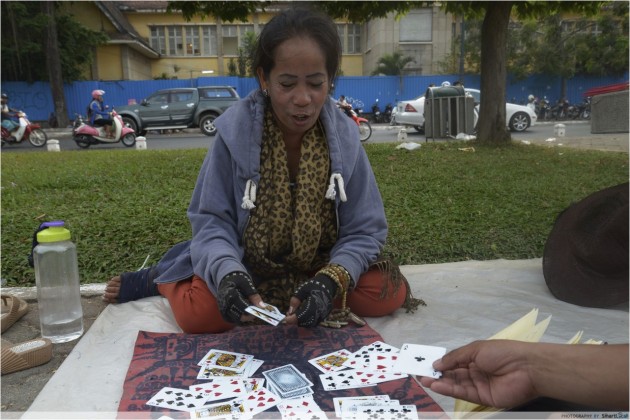 A fortune teller reads the future from her deck of poker cards.
A fortune teller reads the future from her deck of poker cards.
We see a woman in a faded blue pullover and a leopard-print scarf perched on a white groundsheet, a deck of poker cards stacked neatly in front of her. She is heavily mascaraed, her wrists adorned with bangles and prayer beads, her hands encased by intricately patterned black finger gloves.
We have found our fortune teller and a glamorous one at that.
She grins and pulls out red cloth festooned with Khmer script, unfolding it with a practised flourish, before shuffling the deck of cards seven times. I am instructed to cut the deck in half, laying both stacks on the cloth before she arranges each stack into two tidy columns.
I pick a column and she spreads the cards in a semicircle. I pick three, a king of hearts, queen of spades and an eight of clubs, and await her verdict.
“You will find a good job, two years after you finish university. She says you also enjoy traveling, and you always meet good people,” translates Theng. I am rather stunned, having not mentioned anything about university.
This routine is repeated and we establish I will not only meet the girl of my dreams in three years’ time — illustrated by a set of three queens, but also start a family with two children, a boy and a girl.
It is Theng’s turn. He follows the fortune teller’s instructions to a T, an expression of deep concentration masking his boyish features. He looks slightly perturbed as the session proceeds and I ask why.
“She says that while I may have a girlfriend right now, the right one for me may be waiting overseas instead. I have to make a decision soon,” he says.
As Theng ponders how much plane tickets cost and I wonder what I will name my future children, we bid farewell to the fortune teller.
Further up the Quay, yet another sight catches our eye.
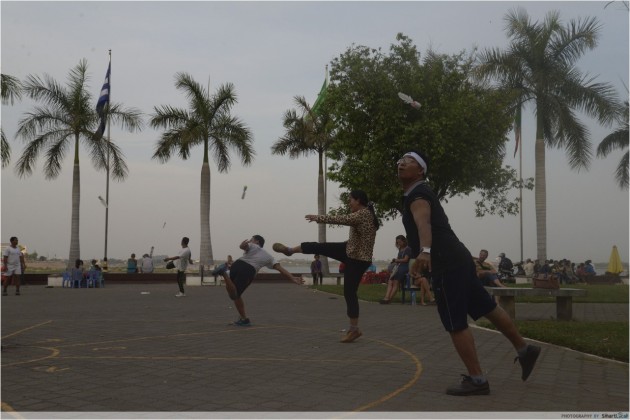 All eyes on the Sey: Locals flick the weighted shuttlecock across a circle to their partners
All eyes on the Sey: Locals flick the weighted shuttlecock across a circle to their partners
A group of locals stand in a circle punting a weighted shuttlecock back and forth. Known as Sey in Cambodia, this recreational sport is played across Southeast Asia.
The men practice in pairs. They anticipate the flight of the weighed shuttlecock before flicking it back, sustaining a series of prolonged rallies. Bored by basic moves, most of them indulge in some showboating. I watch as one thrusts both arms out, forming an O large enough for his friend to boot the incoming sey back across to his partner.
A crowd soon gathers, as the game picks up pace. The men now try to outdo each other in a show of one-upmanship.
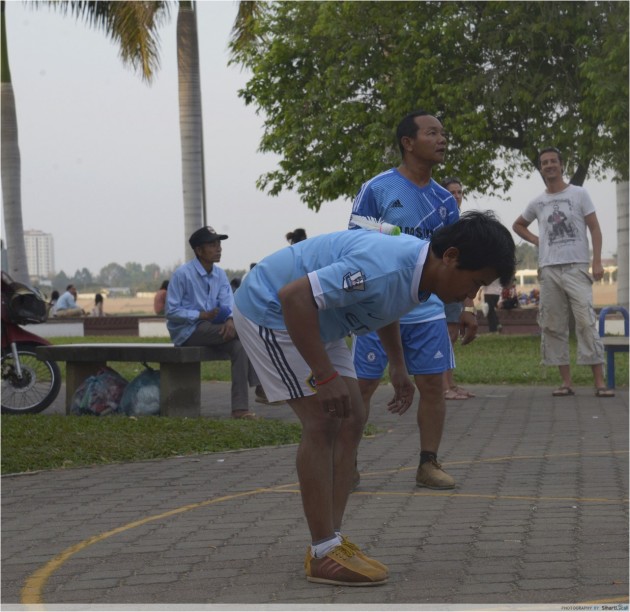 The Sey superstar with his signature move
The Sey superstar with his signature move
The star of the show is a stout, smiley man in a Manchester City jersey. His favourite move involves catching the sey with the back of his neck, before jerking his body upright and flicking the sey back with the sole of his foot. All in one fluid motion. Without looking.
We applaud, amazed by his impudence.
Going With The Flow
I ask Theng if he would like to join in but sheepishly declines. “I cannot play now. They are too good, I will be so embarrassed,” he says.
Despite his reluctance, I feel compelled to join in. As the group pause for a break, I approach one of them, a bespectacled man sporting a white sweatband and ask to learn the ropes.
He gestures at Mr Manchester City, saying: “He is the teacher, you can learn from him.”
While controlling the sey with my instep easy enough, I struggle to maintain a rally. I repeatedly miskick, forcing my teacher into ridiculously acrobatic moves to keep the play going — I wish this was intentional.
As the breeze picks up, the wind is my enemy and I miss more kicks. Yet, my teacher is unaffected, his returns seemingly guided with pinpoint precision.
I am more and more a beaten man, exhausted from chasing the sey. Soon, I admit defeat, apologetically calling the lesson to a halt and thanking my unimpressed teacher.
As I gulp down water, Theng points out a small pavilion. “That is the spot I was telling you about. Cambodians like to sit there and relax, especially in the evening” he adds.
The pavilion is flanked by two shrines, one dedicated to Buddha and another to spirit gods. The locals slip off their footwear, bow to the gleaming Buddha before laying their offerings at his feet. Oblivious to the din outside, they kneel in contemplative prayer, heads bowed, palms pressed together.
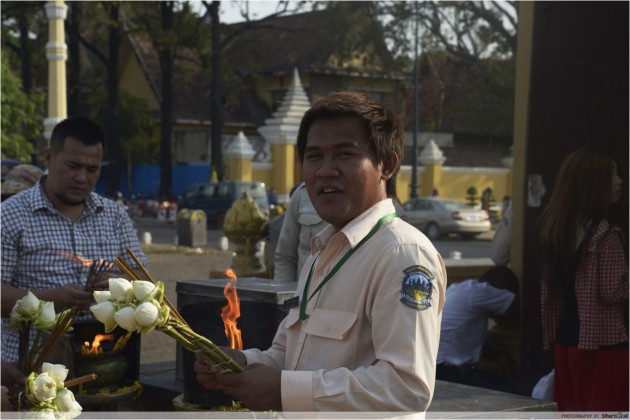 Theng joins in for his daily prayers
Theng joins in for his daily prayers
Theng excuses himself and joins them.
In the pavilion, monks sit with their feet dangled over the railing, snapping selfies with camera phones. Security guards chatter in rapid-fire Khmer, oblivious to their squawking walkie-talkies.
Opposite, the Royal Palace — with its towering spires and ornately gilded roofs, dominates the diminutive skyline. Pinkish orange hues paint it a shimmering contrast to my humble pavilion.
In the distance, the Mekong looks the same. The trawlers still chug past, the water still the same turgid gray, the wispy clouds still bland off-white.
But this time I make out the faint outline of an X in the lapping waters, meters from the pavilion. This must be where the four rivers meet.
I hear the faint strains of the Macarena as another dancexercise class begins. The lights along Sisowath flicker to life, silhouetting the prancing figures. I wonder if I might just join them.
Then, it occurs to me that the tuk-tuk driver was right — I have indeed missed the sunset.
But by now, it doesn’t matter.
Getting To Phnom Penh
Getting There: Silkair and Jetstar fly direct to Phnom Penh daily. Round trip flights from Singapore start from S$260
Where to Stay: Salita Hotel (3 star), ten minutes’ drive from Sisowath Quay
Address: #70, St European Union 143 Boeung Kengkang II,Khan Chamkarmorn, 280, Phnom Penh 00855, Cambodia
Additional Information: Sisowath Quay is opposite the Grand Palace, in the heart of downtown Phnom Penh. An alternative to walking, boat tours down the Mekong are also available from private tour operators.
All pictures by Matthew Mohan.
